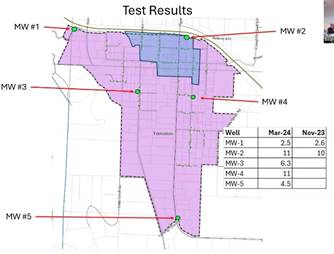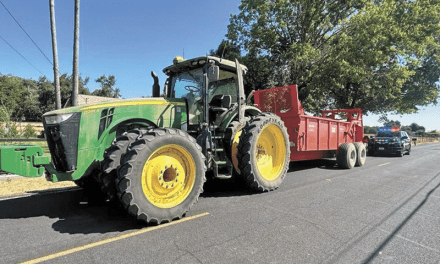Discussion scheduled for Los Olivos Community Services District meeting on Wednesday, May 15
By Michelle de Werd
The Los Olivos community’s involvement in deciding whether the whole town needs a sewer system is essential.
In 2018, the Los Olivos Community Services District was formed, and five board members were sworn in to address the perceived need to replace aging septic systems on the 390 parcels within the district’s boundaries.
Six years later, many neighbors share concerns over escalating assessment fees and ever-increasing expenditures for professional services, projects, planning, and studies already totaling approximately $1 million in taxpayer money.
There are also concerns that a sewer system will lay the groundwork for unchecked sprawl that will overwhelm our bucolic town.
At the same time, the town’s tiny commercial core clearly needs more restrooms, so prioritizing a plan that will address the aging systems struggling to serve the downtown businesses has obvious advantages.
“The lots in the downtown core, on average, generate more wastewater effluent,” according to the Santa Barbara County Environmental Health Services’ Los Olivos Wastewater Management Plan from 2010.
The district’s last proposal, unveiled in early 2022, included construction of a sewage treatment plant.
The proposed site for the sewage plant, located outside the district and complete with effluent ponds and 24-hour outdoor lighting, raised a host of concerns.
Costs for engineering, construction, environmental review, operation and maintenance, and financing for such a large project can conservatively be estimated at well over $100,000 per parcel owner.
While owners would have to pay that cost in the form of increased assessment fees, every parcel owner would also be required to pay upfront and out-of-pocket for their lateral connection to the old-fashioned sewer system.
After repeated neighbor complaints and concerns that such a large and expensive system did not seem warranted, the elected board finally listened, stepped up, and agreed to perform groundwater testing six months ago.
Even before the groundwater monitoring data started to come in, community members were divided about the size of the problem and the size of the solution. Ultimately, the debates come down to “Who should pay?”
Unfortunately, the controversies have sometimes devolved into mistrust, with threatening messages mailed anonymously, neighbors not talking to one another, personal attacks on social media, and a board that views with suspicion offers of donations for a sound system intended to help elderly neighbors hear what is being said during public meetings.
Is there hope for a unified path forward, or is Los Olivos on track to become the next Los Osos? The answer might lie in the results of the groundwater testing.
Fifty years ago, the tiny, historic town of Los Olivos was designated a “Special Problems Area” based on 1974 groundwater monitoring data showing the potential for increasing nitrate levels.
It seems that wells within Los Olivos were not showing levels exceeding the maximum contaminant level (MCL) for nitrates, but the concern was that, because Los Olivos was on septic, it was anticipated that nitrates levels would rise to dangerous levels.
It is important to acknowledge that the presence of high levels of nitrates in groundwater is not just a concern: it is a significant threat to our health and the health of our environment.
The MCL for nitrates in groundwater is 10 mg/l.
Just last month, the results from the CSD’s five new groundwater monitoring wells were presented to the public.
Three of the wells show levels well below the MCL. The other two wells (near the downtown core) reflect nitrates at 11 mg/l: one point above the MCL.
According to the EPA, the MCL for a contaminant is based on the MCLG (maximum contaminant level goal), which is “the maximum level of a contaminant in drinking water at which no known or anticipated adverse effect on the health of persons would occur, allowing an adequate margin of safety.”
In other words, there are no known or anticipated adverse health effects — none — when nitrates measure at or below 10.
Thus, although this Special Problems Area has two wells with nitrate readings of single point over the MCL, those readings are far better than had been anticipated, and it seems reasonable that the 11 mg/l readings, while suboptimal, are still near or within the “margin of safety.”
Questions arise with the first of the two wells showing nitrates at 11 mg/l at the very northeastern corner of the district, and the second well with an 11 mg/l located immediately south of that first well and the commercial core.
In fact, the test results have already led many to question whether the groundwater is already contaminated with slightly elevated nitrate levels when it enters Los Olivos from the north, particularly because the nitrate level is substantially lower (4.5 mg/l) when the groundwater is flowing out at the southern end of this tiny district.
The scientific consensus is clear: aging septic systems generally are not the sole or even the primary, source of nitrates in groundwater.
Nitrates enter groundwater from various sources, including septic systems, animal feed lots, agricultural fertilizers, manure, industrial wastewaters, and landfills.
Some community members are beginning to consider whether the path forward might include revisiting whether district residents — those who have already paid several years of CSD assessment fees in support of this undertaking — should now be able to look to other sources to help remediate contamination that may not even generated by residents of the township.
In other words, if sources north of the district are causing the nitrate levels in two of the town’s monitoring wells to exceed the MCL, that could alleviate a lot of the pressure on the owners of the 390 parcels inside the district’s boundaries to solve the problem with a large sewer system and to pay for it all on their own.
The next general meeting of the LOCSD is scheduled for 6 p.m. on May 15 at the Los Olivos Grange Hall, 2374 Alamo Pintado Ave. Please attend and bring your questions and concerns.
The agenda packet for the meeting can be found at www.losolivoscsd.com/regular-board-meetings. The agenda also contains a link to view the meeting by Zoom.
Michelle de Werd is a resident of Los Olivos





